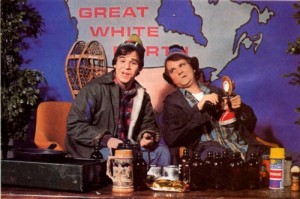
Growing up as a horror fan in Canada during the 70’s and 80’s was a double-edged sword. Yes, we produced a lot of horror flicks during that period, but at the time most of them seemed like half-baked attempts to rip-off American successes. And to a Canadian teen in the 70’s and 80’s, if the slasher flick in question wasn’t American, it wasn’t worth watching (at least until those damn Italian splatter flicks starting infiltrating mom and pop video stores thanks to Wizard Video, but that’s another story). I mean, Hollywood was the home of movies, right, and what teen-ager doesn’t think at one time or another that the place where he or she lives is lame?
To the eagle-eyed Canadian, there were tell-tale signs that the mayhem flickering across our movie or TV screens was not 100% Grade A American slasher content. There were the awkward attempts to disguise the film’s country of origin by sticking American flags in every available corner, the creeping suspicion that all was not as it seemed when character actors you’d seen in countless Canadian TV commercials popped up like dandelions, there was the occasional spotting of Ontario license plates that the film’s budget hadn’t been large enough to deal with, we’d catch actors drinking brands of beer we knew were only sold in Canadian bars, and worst of all… the lilt of our Canadian accent that seemed to add a couple of extra o’s to every vowel. What a difference a few years make… or a couple of decades. Today, some these same films are considered classics of the genre by slasher fans around the world, and I’ve come to embrace Canadiana like I embrace the band Duchess Says, beaver tail pastries, and when need be, Tim Horton’s coffee.
See, Canada’s film industry has always been a micro-industry compared to the output of our American neighbours. To those of you outside our borders, I challenge you to name five Canadian filmmakers. Did you get past David Cronenberg? When you start reducing the numbers to those within a particular genre, like horror, the challenge becomes even more difficult. The fact is we didn’t produce our first horror movie until Julian Roffman’s partial 3-D flick The Mask in 1961. That’s coming pretty late to the party when you consider that the U.S. had been producing classics like Lon Chaney’s The Phantom of the Opera and The Hunchback of Notre Dame since the days of the silents.
Fast forward to the late 1960’s when the government of Canada first created the Canadian Film Development Corporation (later Telefilm). This organization was tasked with stimulating Canadian film production. A few years later in 1975, moviemaking in Canada was further encouraged by a loophole in our tax laws that allowed a 100% tax shelter for anyone investing in Canadian film production. That’s when the industry really kicked into high gear. Although we produced an awful lot of garbage during that period, it was also due to these incentives that David Cronenberg was able to get early work like Shivers (a.k.a. They Came From Within) and Rabid off the ground, and the late, great Bob Clark was able to give us Deathdream, Deranged (both U.S.-Canadian co-productions) and the Canadian proto-slasher classic Black Christmas.
Despite a steady flow of Canuck horror flicks, it was after the international success of Halloween and Friday the 13th that Canada became the place to be if you wanted to shoot a slasher movie. The country’s lightening-fast response to F13 saw Paul Lynch’s Prom Night and Roger Spottiswoode’s Terror Train, each starring Halloween’s Jamie Lee Curtis, both released the same year that Pamela Voorhees was dicing campers at Camp Crystal Lake. A year later, Visiting Hours saw hospital patient Lee (Damien: Omen II) Grant terrorized by a psychotic Michael (Scanners) Ironside, while William Shatner looked on helplessly. Also in 1981, Paul Lynch’s (again) Humongous gave us a half-human weirdo knocking off visitors to a secluded island, though as a slasher flick Humongous is really in its own (junior) league. 1982 was a bloody banner year for Canadian slashers with the release of J. Lee Thompson’s Happy Birthday to Me, George Mihalka’s My Bloody Valentine, and William Fruet’s Funeral Home. Though strippers were being stalked in 1983’s American Nightmare directed by Don McBrearty, the last standout Canadian slasher was also released that same year with Jonathan Stryker’s Curtains. Say what you will about the muddled plot, but the scene on the ice with the hag mask and the scythe is the stuff of nightmares, and I mean that in the most positive sense.
Though the glory days of Canada’s slasher movies and the tax shelter break are long behind us, these films have been rediscovered by younger genre fans. This is in part due to the fact that some have been through the remake meat grinder as well as the accessibility of the originals through DVD. Hell, this has even given me a chance to re-evaluate some of the classics I dismissed when they first hit my snowy Canadian multiplex. And the horror genre itself, just like Telefilm, is alive and kicking in Canada. With George Romero shooting his zombie flicks in Toronto, and Canadian output such as Andrew Currie’s Fido, Bruce La Bruce’s Otto: or Up With Dead People, Rodrigo Gudiño’s shorts The Eyes of Edward James, The Demonology of Desire and The Facts in the Case of Mister Hollow, Bruce MacDonald’s Pontypool, and Canadian-French co-pros like Pascal Laugier’s Martyrs recently hitting theatres and DVD shelves, Canada’s horror future is virtually undead. For indispensable information about the Canadian horror film industry, check out Caelum Vatnsdal’s They Came From Within; A History of Canadian Horror Cinema published by Arbeiter Ring Publishing, www.canuxploitation.com, and any issue of Rue Morgue magazine.


4 Responses to THE GREAT RED NORTH: Canada & Slasher Movies